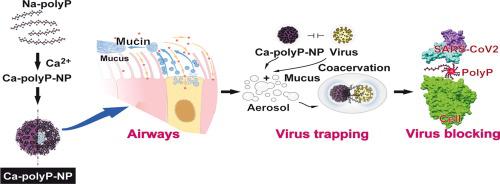当前位置:
X-MOL 学术
›
Mater. Today
›
论文详情
Our official English website, www.x-mol.net, welcomes your feedback! (Note: you will need to create a separate account there.)
An unexpected biomaterial against SARS-CoV-2: Bio-polyphosphate blocks binding of the viral spike to the cell receptor
Materials Today ( IF 24.2 ) Pub Date : 2021-08-02 , DOI: 10.1016/j.mattod.2021.07.029 Werner E G Müller 1 , Heinz C Schröder 1 , Meik Neufurth 1 , Xiaohong Wang 1
Materials Today ( IF 24.2 ) Pub Date : 2021-08-02 , DOI: 10.1016/j.mattod.2021.07.029 Werner E G Müller 1 , Heinz C Schröder 1 , Meik Neufurth 1 , Xiaohong Wang 1
Affiliation

|
No other virus after the outbreak of the influenza pandemic of 1918 affected the world’s population as hard as the coronavirus SARS-CoV-2. The identification of effective agents/materials to prevent or treat COVID-19 caused by SARS-CoV-2 is an urgent global need. This review aims to survey novel strategies based on inorganic polyphosphate (polyP), a biologically formed but also synthetically available polyanionic polymeric material, which has the potential of being a potent inhibitor of the SARS-CoV-2 virus-cell-docking machinery. This virus attaches to the host cell surface receptor ACE2 with its receptor binding domain (RBD), which is present at the tips of the viral envelope spike proteins. On the surface of the RBD an unusually conserved cationic groove is exposed, which is composed of basic amino acids (Arg, Lys, and His). This pattern of cationic amino acids, the cationic groove, matches spatially with the anionic polymeric material, with polyP, allowing an electrostatic interaction. In consequence, the interaction between the RBD and ACE2 is potently blocked. PolyP is a physiological inorganic polymer, synthesized by cells and especially enriched in the blood platelets, which releases metabolically useful energy through enzymatic degradation and coupled ADP/ATP formation. In addition, this material upregulates the steady-state-expression of the mucin genes in the epithelial cells. We propose that polyP, with its two antiviral properties (blocking the binding of the virus to the cells and reinforcing the defense barrier against infiltration of the virus) has the potential to be a novel protective/therapeutic anti-COVID-19 agent.
中文翻译:

一种意想不到的抗 SARS-CoV-2 生物材料:生物多磷酸盐可阻止病毒刺突与细胞受体的结合
1918 年流感大流行爆发后,没有任何其他病毒能像冠状病毒 SARS-CoV-2 那样对世界人口造成如此严重的影响。确定有效的药物/材料来预防或治疗由 SARS-CoV-2 引起的 COVID-19 是全球迫切需要的。本综述旨在调查基于无机聚磷酸盐 (polyP) 的新策略,无机聚磷酸盐是一种生物形成但也可合成的聚阴离子聚合物材料,具有成为 SARS-CoV-2 病毒细胞对接机制的有效抑制剂的潜力。该病毒通过其受体结合域 (RBD) 附着在宿主细胞表面受体 ACE2 上,该受体结合域存在于病毒包膜刺突蛋白的尖端。 RBD 表面暴露出异常保守的阳离子沟,该沟由碱性氨基酸(Arg、Lys 和 His)组成。阳离子氨基酸的这种模式(即阳离子凹槽)在空间上与阴离子聚合物材料(具有聚P)匹配,从而允许静电相互作用。结果,RBD 和 ACE2 之间的相互作用被有效阻断。 PolyP 是一种生理学无机聚合物,由细胞合成,尤其富含于血小板中,通过酶降解和耦合 ADP/ATP 形成释放代谢有用的能量。此外,这种材料还能上调上皮细胞中粘蛋白基因的稳态表达。我们认为,polyP 具有两种抗病毒特性(阻断病毒与细胞的结合并增强针对病毒渗透的防御屏障),有可能成为一种新型的保护/治疗性抗 COVID-19 药物。
更新日期:2021-08-02
中文翻译:

一种意想不到的抗 SARS-CoV-2 生物材料:生物多磷酸盐可阻止病毒刺突与细胞受体的结合
1918 年流感大流行爆发后,没有任何其他病毒能像冠状病毒 SARS-CoV-2 那样对世界人口造成如此严重的影响。确定有效的药物/材料来预防或治疗由 SARS-CoV-2 引起的 COVID-19 是全球迫切需要的。本综述旨在调查基于无机聚磷酸盐 (polyP) 的新策略,无机聚磷酸盐是一种生物形成但也可合成的聚阴离子聚合物材料,具有成为 SARS-CoV-2 病毒细胞对接机制的有效抑制剂的潜力。该病毒通过其受体结合域 (RBD) 附着在宿主细胞表面受体 ACE2 上,该受体结合域存在于病毒包膜刺突蛋白的尖端。 RBD 表面暴露出异常保守的阳离子沟,该沟由碱性氨基酸(Arg、Lys 和 His)组成。阳离子氨基酸的这种模式(即阳离子凹槽)在空间上与阴离子聚合物材料(具有聚P)匹配,从而允许静电相互作用。结果,RBD 和 ACE2 之间的相互作用被有效阻断。 PolyP 是一种生理学无机聚合物,由细胞合成,尤其富含于血小板中,通过酶降解和耦合 ADP/ATP 形成释放代谢有用的能量。此外,这种材料还能上调上皮细胞中粘蛋白基因的稳态表达。我们认为,polyP 具有两种抗病毒特性(阻断病毒与细胞的结合并增强针对病毒渗透的防御屏障),有可能成为一种新型的保护/治疗性抗 COVID-19 药物。


























 京公网安备 11010802027423号
京公网安备 11010802027423号